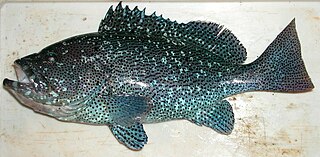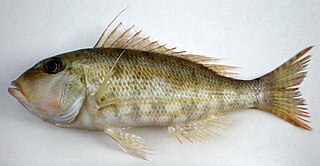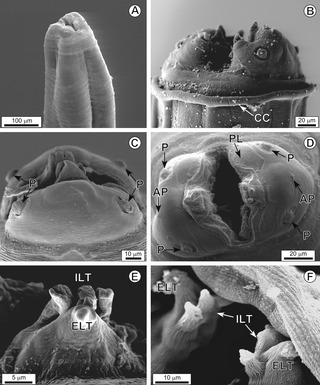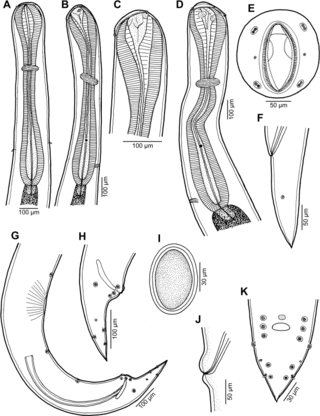
The blacktip grouper, also known as the redbanded grouper, blacktipped cod, black-tipped rockcod, footballer cod, red-barred cod, red-barred rockcod, scarlet rock-cod or weathered rock-cod, is a species of marine ray-finned fish, a grouper from the subfamily Epinephelinae which is part of the family Serranidae, which also includes the anthias and sea basses. It is found in the tropical Indo-Pacific region. It is the type species of the genus Epinephelus.

Philometra is a genus of nematodes, which are parasites of marine and freshwater fishes. The genus was erected by Oronzio Gabriele Costa in 1845.
Philometra priacanthi is a species of parasitic nematode of fishes. Its name is derived from its host species, Priacanthus hamrur. It possesses dorsal lamella-like structures on the distal part of its gubernaculum, which can also be found on other of its cogenerates. The only species with a dorsal protuberance near the gubernaculum's end is P. priacanthi, however. P. lateolabracis can be distinguished from the former by the lateral caudal mounds separated dorsally, narrower lamella-like structures on its gubernaculum, shorter spicules, and by the testis extending anteriorly. Other gonad-infecting species differ from this one by possessing a smooth gubernaculum, and their spicules being of different lengths. Seven gonad-infecting species of Philometra can be distinguished from P. priacanthi by their host types, as well as by geographical distribution.

Philometra cyanopodi is a species of parasitic nematode of fishes, first found off New Caledonia in the South Pacific, in the gonads of Epinephelus cyanopodus. This species is characterized mainly by: length of spicules and length and structure of its gubernaculum; structure of male caudal end; body size; location in host and types of hosts.

Philometra lethrini is a species of parasitic nematode of fishes, first found off New Caledonia in the South Pacific, in the gonads of Lethrinus genivittatus. This species is characterized mainly by: length of spicules and length and structure of its gubernaculum, structure of male caudal end, body size, location in host and types of hosts.
Philometra lagocephali is a species of parasitic nematode of fishes, first found off New Caledonia in the South Pacific Ocean in the abdominal cavity of Lagocephalus sceleratus. This species is characterized mainly by the length of its spicules, length and structure of its gubernaculum, body size, location in host and types of hosts.

Philometra fasciati is a species of parasitic nematode of fishes, first found off New Caledonia in the South Pacific, in the gonads Epinephelus fasciatus. This species is characterized mainly by: length of spicules and length and structure of its gubernaculum; structure of male caudal end; body size; location in host and types of hosts.

Cucullanus is a genus of parasitic nematodes. The genus includes more than 100 species.

Physalopteridae is a family of spirurian nematodes, which belongs to the superfamily Physalopteroidea. Like all nematodes, they have neither a circulatory nor a respiratory system.

Rasheedia is a genus of nematodes in the order Spirurida. The nematode genus BulbocephalusRasheed, 1966 was found to be a homonym of BulbocephalusWatson, 1916 and, therefore, a new name, Rasheedia n. nom., was proposed in 2018 to substitute it.

Rasheedia heptacanthi is a parasitic nematode in the genus Rasheedia.

Rasheedia novaecaledoniensis is a parasitic nematode in the genus Rasheedia.

Ascarophis is a genus of parasitic nematodes, belonging to the family Cystidicolidae. Species of Ascarophis are parasitic as adults in the gastrointestinal tract of marine and estuarine fishes.

Ascarophisnema is a genus of parasitic nematodes, belonging to the family Cystidicolidae. Species of Ascarophisnema are parasitic as adults in the gastrointestinal tract of fish. According to the World Register of Marine Species, the genus currently (2019) includes a single species, Ascarophisnema tridentatum.
Metabronemoides is a genus of parasitic nematodes, belonging to the family Cystidicolidae. Species of Metabronemoides are parasitic as adults in the gastrointestinal tract of fish.
Terranova is a genus of parasitic nematodes. Species from this genus are known to parasitise sharks, rays, sawfishes, teleosts and crocodilians.

Cucullanus variolae is a species of parasitic nematodes. It is an endoparasite of the fish species Variola louti (type-host) and Variola albimarginata. The species has been described in 2020 by František Moravec & Jean-Lou Justine from material collected off New Caledonia in the South Pacific Ocean.

Cucullanus acutospiculatus is a species of parasitic nematodes. It is an endoparasite of a fish, the redbelly yellowtail fusilier, Caesio cuning. The species has been described in 2020 by František Moravec & Jean-Lou Justine from material collected off New Caledonia in the South Pacific Ocean.

Cucullanus diagrammae is a species of parasitic nematodes. It is an endoparasite of a fish, the Painted sweetlips Diagramma pictum. The species has been described in 2020 by František Moravec & Jean-Lou Justine from material collected off New Caledonia in the South Pacific Ocean.

Cucullanus petterae is a species of parasitic nematodes. It is an endoparasite of fish, the Honeycomb grouper Epinephelus merra, which is the type-host, and the Blacktip grouper Epinephelus fasciatus. The species has been described in 2020 by František Moravec & Jean-Lou Justine from material collected off New Caledonia in the South Pacific Ocean.
















